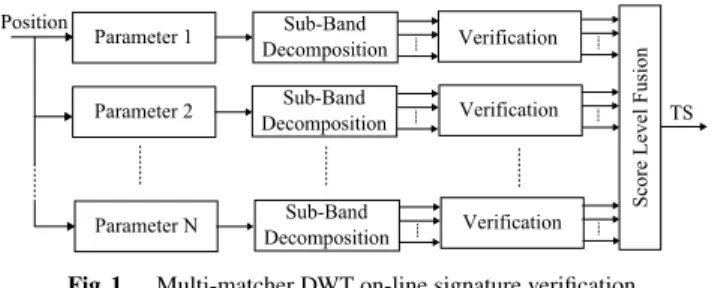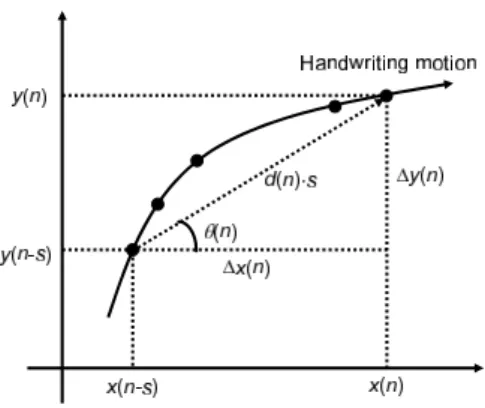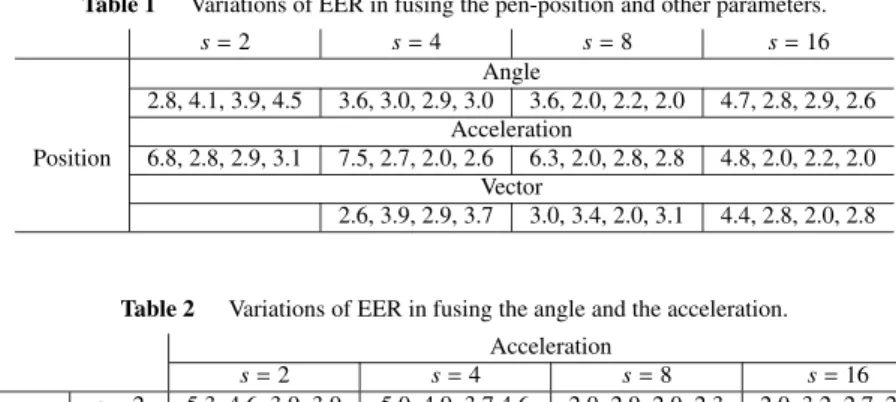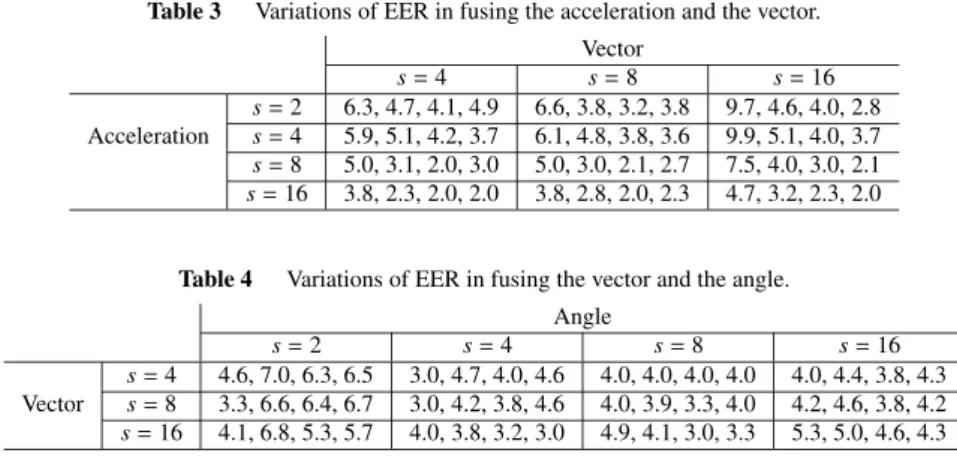2244
IEICE TRANS. FUNDAMENTALS, VOL.E91–A, NO.8 AUGUST 2008
LETTER
Threshold Equalization for On-Line Signature Verification
Isao NAKANISHI†a), Member, Hiroyuki SAKAMOTO†∗, Student Member, Yoshio ITOH†, Member, and Yutaka FUKUI†, Fellow
SUMMARY In on-line signature verification, complexity of signature shape can influence the value of the optimal threshold for individual sig-natures. Writer-dependent threshold selection has been proposed but it re-quires forgery data. It is not easy to collect such forgery data in practical applications. Therefore, some threshold equalization method using only genuine data is needed. In this letter, we propose three different threshold equalization methods based on the complexity of signature. Their e ffec-tiveness is confirmed in experiments using a multi-matcher DWT on-line signature verification system.
key words: on-line signature verification, score level fusion, threshold equalization, multi-matcher, DWT
1. Introduction
Use of biometrics for person authentication is attracting a lot of attention [1]. One of the well-known behaivioral biometrics is on-line signature, which recognizes the sig-natures of users based on time-varying parameters such as pen-position, pen-pressure, pen-inclination and so on [2]– [5]. Especially, only the pen-position parameter is available when the on-line signature verification is assumed to be car-ried out in the context of a personal digital assistant (PDA). However, the pen-position data can be forged since the sig-nature shape is visible.
In order to cope with the above problem, we have in-troduced the notion of sub-band decomposition by the dis-crete Wavelet transform (DWT) into the on-line signature verification process [6]. Moreover, in order to improve the verification performance, we have proposed a multi-matcher DWT on-line signature verification system [7], [8]. How-ever, we noticed that fusing the best matchers did not always result in the best matching pair. One of the reasons is that the optimal threshold for each signature is different. This effect has been observed in a number of related studies [3], [10].
In this letter, we introduce threshold equalization meth-ods into the decision making stage. Their effectiveness is confirmed based on experimental results using the multi-matcher DWT on-line signature verification system de-scribed in [7].
Manuscript received January 22, 2008. Manuscript revised April 9, 2008.
†The authors are with the Graduate School of Engineering,
Tottori University, Tottori-shi, 680-8552 Japan.
∗Presently, with the Sumitomo Heavy Industries Ltd.
a) E-mail: nakanishi@ele.tottori-u.ac.jp DOI: 10.1093/ietfec/e91–a.8.2244
2. Multi-Matcher DWT On-Line Signature Verifica-tion
First, we briefly explain the multi-matcher DWT approach for on-line signature verification. See [6]–[9] for more de-tails. The block diagram of the multi-matcher DWT on-line signature verification approach is shown in Fig. 1. The pen-position input consists of x and y coordinates. Moreover, we also use the pen-movement angle, the pen-movement acceleration, and the pen-movement vector parameters, all of which can be derived from the pen-position data [7]–[9]. These parameters are, respectively, as position, angle, accel-eration, and vector for convenience.
Figure 2 shows the definition of parameters, where s is a constant that defines the time shift in each parameter. It has an influence on verification performance [7]. Small s causes excess fluctuation in a parameter and inversely large
s neglects the difference between a genuine signature and
its forgery. The vector∗∗ is given by multiplying unit pen-movement distance d(n) by the angleθ(n) [8].
The time-varying signal of each parameter is decom-posed into sub-band signals using the DWT. A verification score is obtained at each sub-band level for each parame-ter. At the decision stage, all verification scores are fused based on a weighted-sum rule to obtain the total score (TS). When the total score is larger than a threshold, the user is recognized as genuine.
Based on this scheme, the multi-matcher DWT ap-proach was evaluated in [7]. As a result, the best matched pair was obtained by combining the angle at s = 2 and the acceleration at s = 8. On the other hand, the results also suggested that if the parameters which individually achieved
Fig. 1 Multi-matcher DWT on-line signature verification.
∗∗Strictly speaking, this is not a vector but we call so for
conve-nience.
LETTER
2245
Fig. 2 Definition of pen-movement parameters.
the best performance were fused, it was not always guaran-teed to obtain the best performance. In fact, the best perfor-mance (matcher) was individually obtained using the angle with s= 4 and the acceleration with s = 16.
One of the reasons is that the optimal threshold for each signature is different. Figure 3 shows examples of error rate curves of four users, where 2(a) shows the results of fusing individual best matchers, that is, the angle at s= 4 and the acceleration at s= 16 and 2(b) shows the results of the best matcher pair, that is, the angle at s= 2 and the acceleration at s = 16. While it is easier to set an optimal threshold which is common to all users in 2(b), it is clear that such a common threshold achieves lower performance as shown in 2(a).
This result is related to the idea of writer-dependent threshold selection, which sets an optimal threshold de-pending on the writer (user) [3], [10]. Furthermore, it is generalized as the user-specific matching threshold in [11]. The writer-dependent threshold values are found empiri-cally based on error rates: Equal Error Rate (EER), False Acceptance Rate (FAR) and False Rejection Rate (FRR), which require the availability of forgeries. In general, bio-metric data of other users are used as impostor data. In the case of signatures, to use of other users’ signatures as forg-eries is called the random forgery scenario. However, as mentioned earlier the signature has the problem that it can be easily forged; therefore, it is reasonable to assume more severe or adverse conditions, that is, simulated forgery in which genuine signatures are traced by forgers and/or the skilled forgery in which genuine writing styles are learned by forgers. However, it is difficult to collect such forgery data in practical applications since others must imitate gen-uine signatures whenever a new user is registered to a sys-tem.
In this letter, we propose to equalize optimal thresh-olds for users based on the complexity of their own signa-tures. This scheme does not require any forgery data and so is called threshold equalization to distinguish it from con-ventional user-specific threshold matching.
3. Threshold Equalization Methods
As a result of investigating the relationship between
opti-Fig. 3 Error rate curves of individual users in (a) individual best matchers and (b) the best matcher pair.
mal thresholds and individual user signatures, we observed that the higher the complexity of a signature, the smaller the optimal threshold. This fact is explained as follows. In general, a complex signature requires long writing time, re-sulting in large variation in the signature of one individual (large intra-class variation). Such large variation makes the total match score smaller even when the signature is gen-uine. On the other hand, when the signature shape is simple, the writing time is short and the signature is relatively sta-ble. This makes the intra-class variation small and then the total match score becomes larger for genuine trials.
Thus, the different complexities of signature shape might cause different optimal thresholds for individual sig-natures. In the following sections, we propose three thresh-old equalization methods based on the complexity of a sig-nature.
3.1 Method Based on Average Number of Samples The first method is based on the simple idea that a complex signature requires more time for its writing, so that it in-creases the number of sampled data of the signature. The
2246
IEICE TRANS. FUNDAMENTALS, VOL.E91–A, NO.8 AUGUST 2008
complexity of a signature is measured by counting the num-ber of samples in the template. The equalized threshold is achieved by normalizing a total score as follows:
T Sieq= kaveNiT Si (1)
where i is the user (signature) number, T Siis the total score of the ith user, T Si
eq is the equalized total score, Ni is the
average number of samples in the templates of the ith user
and kaveis a coefficient for adjusting the equalized total score
between 0 and 1.
If the complexity of a signature is high, then we have hypothesized that the total score T Siwill be small. In such
a case, the small T Siis multiplied by the large Ni, so that we obtain an equalized T Si
eq.
3.2 Method Based on Number of Negative Samples In this method we examine the complexity of a signature using the number of samples with a negative value in the pen-movement angle parameter. Assuming that the average direction of pen-movement is from left to right on a tablet, the negative value of the angle parameter means that the pen moves in the opposite direction. Therefore, a large number of samples with a negative value in the angle suggests that the signature includes frequent back and forth movements and is complicated.
The equalized threshold is achieved by
T Sieq= kminMiT Si (2)
where kminis the coefficient for adjustment, Miis the average
number of samples with a negative value of the angle in the user i template. The scheme for equalization the threshold is similar to that of the averaging method.
3.3 Method Based on Number of Sign-Inversions
Lastly, we propose to examine the complexity of a signature using the number of sign-inversions in the angle parameter. The sign-inversion in the angle corresponds to the direction
change in pen-movement. In general, a complex signature has many direction changes. Thus, we define the threshold equalization method as
T Sieq= ksinSiT Si (3)
where ksinis the coefficient for adjustment and Siis the
av-erage number of sign-inversions in the angle in the user i template. The scheme for equalization is similar to the other two methods.
4. Verification Experiments
In order to evaluate the effectiveness of the three proposed threshold equalization methods which are called Average method, Negative method, and Sign method for convenience sake, we carried out the following verification experiments. Four subjects were requested to sign their own signa-tures and then we obtained 118 genuine signasigna-tures. Five genuine signatures for each subject were used to make a template and the remaining 98 genuine signatures were used for verification. Five subjects were required to counterfeit the genuine signature 10 times each, so that 200 forgeries were prepared in total. In order to obtain the number of sam-ples with a negative value or of sign-inversions in the angle parameter, we utilized the data with the time shift s = 2. The coefficient for adjustment for each method was selected empirically. When pen-position parameters (x, y) are fused with another parameter, the weighting factors for fusing of x, y and another parameter were 2/5, 1/5 and 2/5, respec-tively. When two parameters except the pen-position were fused, each weighting factor was 1/2. For lack of space, we omit other conditions. Please refer to [6]–[8] for details.
Tables 1–4 show the variations in EER by applying the three proposed threshold equalization methods in several fu-sion cases. In each column, the EERs with no equalization, by the Average method, by the Negative method and by the Sign method are presented from the left to the right.
Among total 153 cases, the verification performance was improved or unchanged in 122 cases by using the pro-posed methods. It corresponds to the improvement rate of
Table 1 Variations of EER in fusing the pen-position and other parameters.
s= 2 s= 4 s= 8 s= 16 Angle 2.8, 4.1, 3.9, 4.5 3.6, 3.0, 2.9, 3.0 3.6, 2.0, 2.2, 2.0 4.7, 2.8, 2.9, 2.6 Acceleration Position 6.8, 2.8, 2.9, 3.1 7.5, 2.7, 2.0, 2.6 6.3, 2.0, 2.8, 2.8 4.8, 2.0, 2.2, 2.0 Vector 2.6, 3.9, 2.9, 3.7 3.0, 3.4, 2.0, 3.1 4.4, 2.8, 2.0, 2.8
Table 2 Variations of EER in fusing the angle and the acceleration. Acceleration s= 2 s= 4 s= 8 s= 16 s= 2 5.3, 4.6, 3.9, 3.9 5.0, 4.9, 3.7 4.6 2.0, 2.9, 2.0, 2.3 2.0, 3.2, 2.7, 2.8 Angle s= 4 8.4, 1.9, 3.0, 1.8 7.3, 3.0, 2.5, 2.2 6.0, 1.6, 1.4, 1.3 4.6, 1.6, 1.0, 1.0 s= 8 8.8, 3.0, 2.0, 2.1 8.4, 2.8, 2.9, 2.7 6.2, 1.5, 1.0, 1.0 3.5, 2.0, 1.9, 1.9 s= 16 8.8, 3.3, 3.1, 2.7 8.0, 4.6, 3.8, 3.0 7.0, 1.7, 1.7, 1.2 4.6, 3.9, 2.9, 2.3
LETTER
2247
Table 3 Variations of EER in fusing the acceleration and the vector. Vector s= 4 s= 8 s= 16 s= 2 6.3, 4.7, 4.1, 4.9 6.6, 3.8, 3.2, 3.8 9.7, 4.6, 4.0, 2.8 Acceleration s= 4 5.9, 5.1, 4.2, 3.7 6.1, 4.8, 3.8, 3.6 9.9, 5.1, 4.0, 3.7 s= 8 5.0, 3.1, 2.0, 3.0 5.0, 3.0, 2.1, 2.7 7.5, 4.0, 3.0, 2.1 s= 16 3.8, 2.3, 2.0, 2.0 3.8, 2.8, 2.0, 2.3 4.7, 3.2, 2.3, 2.0
Table 4 Variations of EER in fusing the vector and the angle. Angle
s= 2 s= 4 s= 8 s= 16
s= 4 4.6, 7.0, 6.3, 6.5 3.0, 4.7, 4.0, 4.6 4.0, 4.0, 4.0, 4.0 4.0, 4.4, 3.8, 4.3 Vector s= 8 3.3, 6.6, 6.4, 6.7 3.0, 4.2, 3.8, 4.6 4.0, 3.9, 3.3, 4.0 4.2, 4.6, 3.8, 4.2
s= 16 4.1, 6.8, 5.3, 5.7 4.0, 3.8, 3.2, 3.0 4.9, 4.1, 3.0, 3.3 5.3, 5.0, 4.6, 4.3
about 80%. The Averaging method was suitable in fusing the pen-position parameter. On the other hand, the Neg-ative and the Sign methods achieved comparable improve-ment of the EER when other parameters were fused. In addi-tion, although the purpose of this letter is not to evaluate the absolute verification performance, it is interesting that the best verification rate of 99.0% in our system was achieved when the angle (s = 4, 8) was fused with the acceleration (s= 8, 16).
We can also observe in some cases that the EER was degraded by the proposed threshold equalization methods, for example when combining the vector and the angle (see Table 4), which requires further examination. In addition, more work needs to be done in order to estimate the adjust-ment parmeters, based either on experiadjust-mental knowledge or statistical formulation.
5. Conclusions
In order to equalize optimal thresholds of individual signa-tures, we have proposed to adjust the total score according to the complexity of a signature and evaluated the scheme in verification experiments. The results confirmed that the pro-posed threshold equalization methods are effective for im-proving the verification performance. On the other hand, it is not always guaranteed that the performance will be improved using the proposed methods. In addition, there may be some more sources which cause different optimum thresholds. The effect of the proposed methods is not eval-uated yet when other combinations of parameters are at-tempted. These are future problems to be studied.
Acknowledgments
This work was partially supported by KAKENHI (17560340) and Electric Technology Research Foundation of CHUGOKU. The authors would like to thank Prof. Jain from Michigan State University, USA and Dr. Fierrez from
Universidad Autonoma de Madrid, Spain for their valuable comments.
References
[1] A. Jain, R. Bolle, and S. Pankanti, eds., BIOMETRICS Personal Identification in Networked Society, Kluwer Academic Publishers, Massachusetts, 1999.
[2] R. Plamondon and S.N. Srihari, “On-line and off-line handwriting recognition: A comprehensive survey,” IEEE Trans. Pattern Anal. Mach. Intell., vol.22, no.1, pp.63–84, Jan. 2000.
[3] A.K. Jain, F.D. Griess, and S.D. Connell, “On-line signature verifi-cation,” Pattern Recognit., vol.35, no.12, pp.2963–2972, Dec. 2002. [4] G. Dimauro, S. Impedovo, M.G. Lucchese, R. Modugno, and G. Pirlo, “Recent advancements in automatic signature verifica-tion,” Proc. 9th International Workshop on Frontiers in Handwriting Recognition, pp.179–184, Oct. 2004.
[5] J. Fierrez and J. Ortega-Garcia, “On-line signature verification,” in Handbook of Biometrics Chapter 10, ed. A.K. Jain, P. Flynn, and A.A. Ross, Springer, New York, 2007.
[6] I. Nakanishi, N. Nishiguchi, Y. Itoh, and Y. Fukui, “On-line signa-ture verification method on discrete wavelet domain adaptive sig-nal processing,” in Biometric Authentication, ed. D. Zhang and A. Jain, (Proc. ICBA2004), Springer Berlin/Heidelberg, pp.584–591, July 2004.
[7] I. Nakanishi, H. Sakamoto, N. Nishiguchi, Y. Itoh, and Y. Fukui, “Multi-matcher on-line signature verification system in DWT do-main,” IEICE Trans. Fundamentals, vol.E89-A, no.1, pp.178–185, Jan. 2006.
[8] I. Nakanishi, H. Sakamoto, N. Nishiguchi, Y. Itoh, and Y. Fukui, “DWT domain on-line signature verification using the pen-movement vector,” IEICE Trans. Fundamentals, vol.E89-A, no.4, pp.1129–1131, April 2006.
[9] I. Nakanishi, H. Hara, H. Sakamoto, Y. Itoh, and Y. Fukui, “Pa-rameter fusion in DWT domain on-line signature verification,” Proc. 2006 International Conference on Intelligent Signal Processing and Communication Systems, pp.395–398, Dec. 2006.
[10] J. Fierrez-Aguilar, J. Ortega-Garcia, and J. Gonzalez-Rodriguez, “Target dependent score normalization techniques and their appli-cation to signaute verifiappli-cation,” IEEE Trans. Syst. Man Cybern. C, Appl. Rev., vol.35, no.3, pp.418–425, Aug. 2005.
[11] A.A. Ross, K. Nandakumar, and A.K. Jain, Handbook of Multibio-metrics, Springer, New York, 2006.



